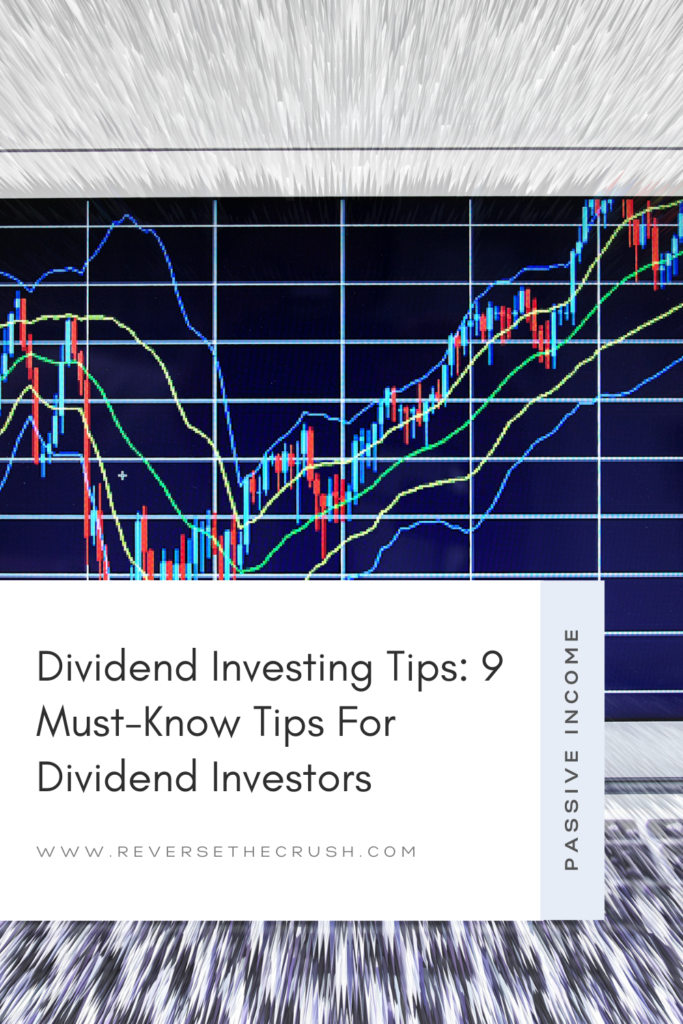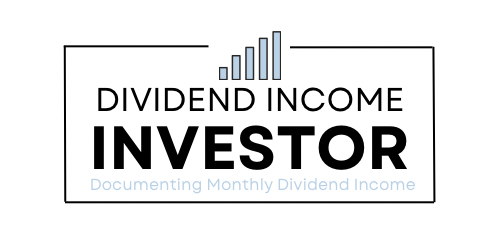Dividend investing tips: 9 must-know tips for dividend investors to create a growing passive income stream in no time.
Dividend investing is an investment strategy that involves buying stocks that pay dividends.
It’s an excellent strategy for financial independence seekers, because it provides tangible income that can be used to live off in retirement.
This way, investors can avoid selling the principal amount they originally invested. Instead, they can live off the investment income and keep the principal untouched.
Personally, dividend investing is my main investment strategy. I’ve been chronicling my monthly dividend income on this blog since 2017.
During this time, I’ve learned a lot about managing a dividend income portfolio, especially now that I’ve lived through a global pandemic.
As such, I wanted to share some of the lessons I learned.
In this post, I will share 9 must-know dividend investing tips that will help you develop a successful dividend investing strategy.
Let’s dive in.
Dividend Investing Tips

Dividend Investing Tips: 9 Must-Know Tips For Dividend Investors
1. Don’t Chase High Yield
It might be tempting to chase high dividend yields in the early going.
But over the long term, the pursuit of high yields could hold you back.
In fact, stocks with high dividend yields could be a warning sign. The stock price may have fallen, causing the yield to be high. It could indicate it’s a value trap.
Simply put, stocks will high yields are at a greater risk of experiencing a dividend cut.
Once the dividend is cut or slashed, you will earn less dividend income.
In my opinion, it’s better to make slow and steady progress than it is to take on more risk and suffer a setback.
2. There’s More To An Investment Return Than Dividends
Even though my investment strategy is primarily focused on dividend income, I don’t buy stocks solely based on their dividends. That would be silly.
Frankly, there’s a lot more to investing than dividends. You must learn how to calculate your total returns.
Capital gains and capital appreciation play a significant role too.
If you’re going to buy dividend stocks without analyzing other investment metrics, you should just buy an index fund instead, because you’re probably leaving money on the table.
Most quality stocks pay a dividend of 5% or less, which is less than the average annual return of the S&P 500. If you’re not outperforming the average annual return of the market, you might as well buy the market.
Ideally, you want the combination of dividends and capital appreciation to outperform the market.
At the end of the day, you want the market capitalization to increase when you buy a stock. You don’t want to be taking money out of a company that isn’t even growing its business.
“Whenever you invest in any company, you’re looking for its market cap to rise. This can’t happen unless buyers are paying higher prices for the shares, making your investment more valuable.” — Peter Lynch
3. Look At The Dividend Payout Ratio
Dividend payout ratio is one of the key investing metrics I look at before purchasing a stock.
In short, the dividend payout ratio will tell you how much of the company’s earnings are being paid out as dividends.
A payout ratio less than 60% is preferable, but it does depend on the industry.
If a company is consistently paying out more than 100% of its earnings, there is a chance that it will have to cut its dividend.
Alternatively, a company with a lower dividend payout ratio has room to increase its dividend payment.
Of course, some companies may have one-off years that see the dividend payout ratio greater than 100% if they are reinvesting back in the business. In these cases, it’s a good idea to look at the average payout ratio over 5 to 10 years.
4. Analyze At Least 10 Years Of The Dividend History
In some careers, the ability to make quick decisions is a good thing.
However, when it comes to investing, making quick decisions could be an indication you don’t know what you are doing, or that you haven’t developed an investment strategy that you can stick to.
Unless you work in the investment industry as a hedge fund manager, there is no time limit or reason to rush.
One of the most overlooked advantages retail investors have is time. Your investments don’t have to become profitable immediately—they just need to be profitable over a span of 5 years.
So, take the time to analyze as much dividend history as possible.
Ideally, you want to invest in companies that have been paying and raising dividends for at least 10 years or more.
5. Find Companies That Are Growing Earnings
In the short term, poor companies can appear like they are doing well.
But over the long term, only companies that are growing earnings will do well. It’s that simple.
Of course, there are different ways to grow earnings, such as organic growth, growth through acquisitions, or share buybacks. The key is that the growth is sustainable and right for the company.
For example, you don’t want to see a company buying back its stock at overvalued prices. That would indicate that they are out of ways to grow the business organically. It could be a sign of poor management.
But if the stock is undervalued, share buybacks are a savvy move to increase the investors’ share of the pie.
In turn, the company will generate higher earnings per share, which means they have more cash flow to increase dividends.
If the company is growing revenue organically by selling more products and services, they will have more cash flow for dividends.
Alternatively, if they are increasing by acquisitions, the management must be able to successfully implement the new business. This way, they will have more earnings to raise dividends.
Ultimately, you want to find companies that are increasing earnings, because those are the companies that will be able to raise dividends.
6. Favour Dividend Growth Stocks
Dividend investors should favour dividend growth stocks over high yielding stocks.
Over time, the yield on cost will grow and inevitably turn low yields into high yields.
For instance, if you buy a stock with a yield of 2% but it is increasing its dividend by 10% per year, that 2% yield will more than double to 5.19% over 10 years. So, you will actually earn 5.19% from dividends on your original investment, even though the stock price may be higher.
On the other hand, if you buy a stock with a high dividend yield now, but it doesn’t grow its dividend, you are limited to the same payment as you were when you bought it. If you factor in inflation, the high dividend payment might not have as much buying power anymore.
Essentially, you should favour dividend growth stocks that outpace inflation.
7. Reinvest Your Dividends
Depending on what stage of an investor you are, you should reinvest your dividends.
If you are 80 to 90, by all means, start spending your dividends.
However, if you are a younger investor, you absolutely have to reinvest your dividends.
This is one of the biggest keys about dividend investing that the layman fails to understand.
Dividend investing is a long-term game that relies on compound growth.
Let me say that again—dividend investing is a long-term game that relies on compounding.
To put it bluntly, in the short term, dividend investing is not even that good of a strategy.
Many growth stocks will blow dividend investing out of the water in a 2-to-5-year time frame. And they should, because dividends are paid from companies that are in a more mature stage of the business cycle. Growth has slowed.
But over a 10, 20, or 30-year time frame, that’s where dividend investors win.
For growth investors, it’s challenging to select multiple winning growth stocks in an investing career. Some of your picks will do exceptionally well, and some will underperform.
With dividend investing, reinvesting the dividend income allows compound interest to take over.
8. Consider Tax Implications
Another one of the overlooked dividend investing tips I have for you involves a topic most people don’t want to think about—income taxes.
Even dividend investing involves proper tax planning.
Depending on where you live, you need to figure out what the best investment accounts are for tax purposes.
For example, I hold most of my Canadian dividend stocks in a Tax-Free Savings Account (TFSA) because there’s no tax on dividends.
Additionally, I hold all my USD stocks in a Registered Retirement Savings Plan (RRSP) because I avoid tax on dividends.
If I were to hold USD stocks in a TFSA, I would incur a non-resident withholding tax on dividends.
If I hold stocks in a non-registered investment account, I only hold Canadian dividend stocks because I receive a tax credit.
9. Limit Commission Costs
Ideally, you want to keep your investment expenses as low as possible.
You should only pay a commission if the return you can make on the investment makes sense.
Of course, it costs money to make money.
So, you may incur some fees as a dividend investor.
There are commission costs, withdrawal fees, and some accounts have maintenance fees.
Fortunately, investment fees are dramatically lower than they used to be.
Zero-commission and lower commission brokers have made investing more affordable than ever.
I would recommend that you take advantage of zero-commission brokers such as WealthSimple if possible.
The lower you can keep your commission fees, the higher your returns will be and the more money you will have to buy dividend stocks.

Dividend Investing Tips – Final Thoughts
In addition to the 9 dividend investing tips mentioned in this post, try to remember that dividend investing is a long-term game.
Take it seriously and treat it like a personal business.
Don’t just track your dividend income, track your total annual returns to know how well you are doing.
If you regularly pay yourself first and follow these 9 dividend tips, you will have a growing income stream on your hands in no time.
Now I’d like to hear from you. Are there any other dividend investing tips you would add to the list?
Related Articles You Might Like On Investing
Investing Metrics For Research On Stocks: 10 Key Metrics
Dividend Growth Stocks: The Top 9 Dividend Growth Stocks This Year
Dividend Income Updates Since 2017
I am not a licensed investment or tax adviser. All opinions are my own. This post may contain advertisements by Monumetric and Google Adsense. This post may also contains internal links, affiliate links to BizBudding, Amazon, Bluehost, and Questrade, links to trusted external sites, and links to RTC social media accounts.
Connect with RTC
Twitter: @Reversethecrush
Pinterest: @reversethecrushblog
Instagram: @reversethecrush_
Facebook: @reversethecrushblog
Email: graham@reversethecrush.com


 How To Find Which Stocks To Buy
How To Find Which Stocks To Buy
